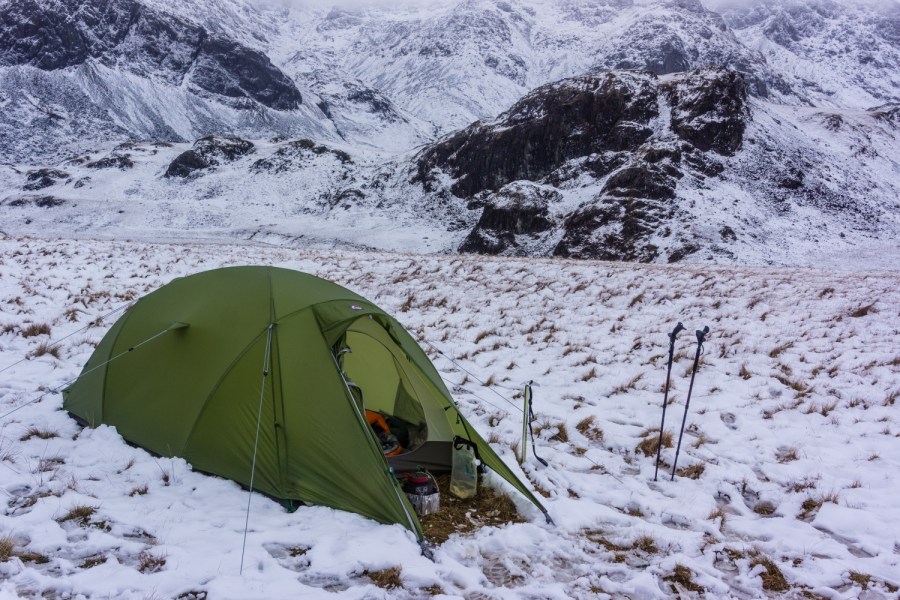Force Ten’s latest take on the well-established four-pole geodesic dome design is strong and roomy with a few details that differentiate it from similar tents.
Tents like this are designed for high mountain use where they may have to cope with strong winds and heavy snow. A word often used for the design is ‘bombproof’.
The MTN2 certainly fits this description. Whilst it’s as light as is feasible without compromising the performance it’s not a tent for lightweight let alone ultralight backpackers. It’ll sleep two, which means a weight of 1.7kg each, and is spacious for one if you don’t mind the weight and the packed bulk.
The strength and size means it’s great for base camps in the mountains and I think it’s worth the effort of carrying it up there. I wouldn’t choose it for long distance walks however – though it would be good on ski trips where gear was pulled on a sledge.
The MTN2 is made from tough fabrics, as you’d expect. The flysheet is silicone treated on the outside and polyurethane coated on the inside so the seams can all be taped. The tray groundsheet has high walls and again the seams are taped. The groundsheet fabric is more substantial than that found on lighter weight tents.
There’s still a footprint available if you want extra protection. The inner is breathable nylon with closable vents in the roof and double-doors at each end – either mesh for airflow and to keep insects out or solid nylon for warmth and protection.
The MTN2 is quite easy to pitch. Being geodesic it’s free-standing but unless it’s dead calm I’d still peg down one end so it doesn’t blow away. Rather than running through sleeves the poles are clipped onto the inner tent. The main poles, which form the dome shape, are linked by a central hub, which Force Ten says adds strength.
The inner can be pitched quite quickly but could still get wet in heavy rain. If you have the footprint the flysheet can be pitched first and then the inner tent clipped into place. I haven’t tried the footprint or this method but I can see that the footprint would be needed to clip the pole ends onto as these don’t attach directly to the flysheet.
Once the inner is pitched the flysheet can be thrown over, attached to the centre of each side and clipped to the inner. Then the two porches and the six guylines can be pegged out. The provided pegs are long pins, which are okay in firm ground but can loosen and even pull out in soft ground. At least a few wider pegs would be a good idea. With a little practice the MTN2 can be pitched by one person in ten minutes. It’s also fairly easy to pitch when wearing gloves.
The MTN2 is roomy inside with good headroom (105cms in the centre). There are mesh pockets on the walls and loops for hanging items such as headlamps. The porches aren’t that big and great care and a low profile stove are needed if cooking with them fully closed. However each porch can be opened in the centre and at either side so it should always be possible to cook in an open doorway away from the wind though this may mean moving gear from one end of the tent to the other at times.
On a two-night camp in the Lake District I moved my stove from one porch to the other four times as the wind kept changing direction. Whilst it would add weight it would be good to see a version with an extra pole at one end to make a much bigger porch.
In use in the Lakes and in the Cairngorms the MTN2 has proved a very wind-resistant tent, only moving slightly in winds that would have had lighter tents shaking wildly. This gives a good feeling of security and less disturbed sleep. The tent also kept out heavy rain and wet snow, which just slithered off the flysheet. I did find that in strong winds the ladder-style buckles on the porch pegging points slipped slightly, leaving the porches flapping a bit.
This can be solved by pegging down the loops at the end of the webbing by the buckles. (Thanks to Terry Abraham for that tip). The buckles attaching the flysheet to the inner didn’t slip so this isn’t a big problem. The Line-Lok runners on the guylines didn’t slip either.
The only drawback I found to the MTN2 was that the inner tent doors slope inwards more than on some similar tents, which means that the flysheet doors are above the groundsheet. When the flysheet is wet or snow-covered care is needed when unzipping the doors or else water or snow can fall into the inner. If there’s condensation on the inside of the flysheet – unavoidable in some conditions – this can drip into the inner.
Having been woken by rain falling on my face when I left the fly door open one night and by condensation dripping on me on another night I realised that this is a tent best used with inner and outer doors closed unless it’s calm and dry. When conditions are suitable both ends of the flysheet can be completely opened, giving excellent views and easy access. And if snow builds up round the tent the top half of the flysheet doors can be opened so you can get out without the snow falling into the porches.
The MTN2 is expensive but it should last for many years. I wouldn’t recommend it for general backpacking but for mountain camping in severe weather it’s excellent.








